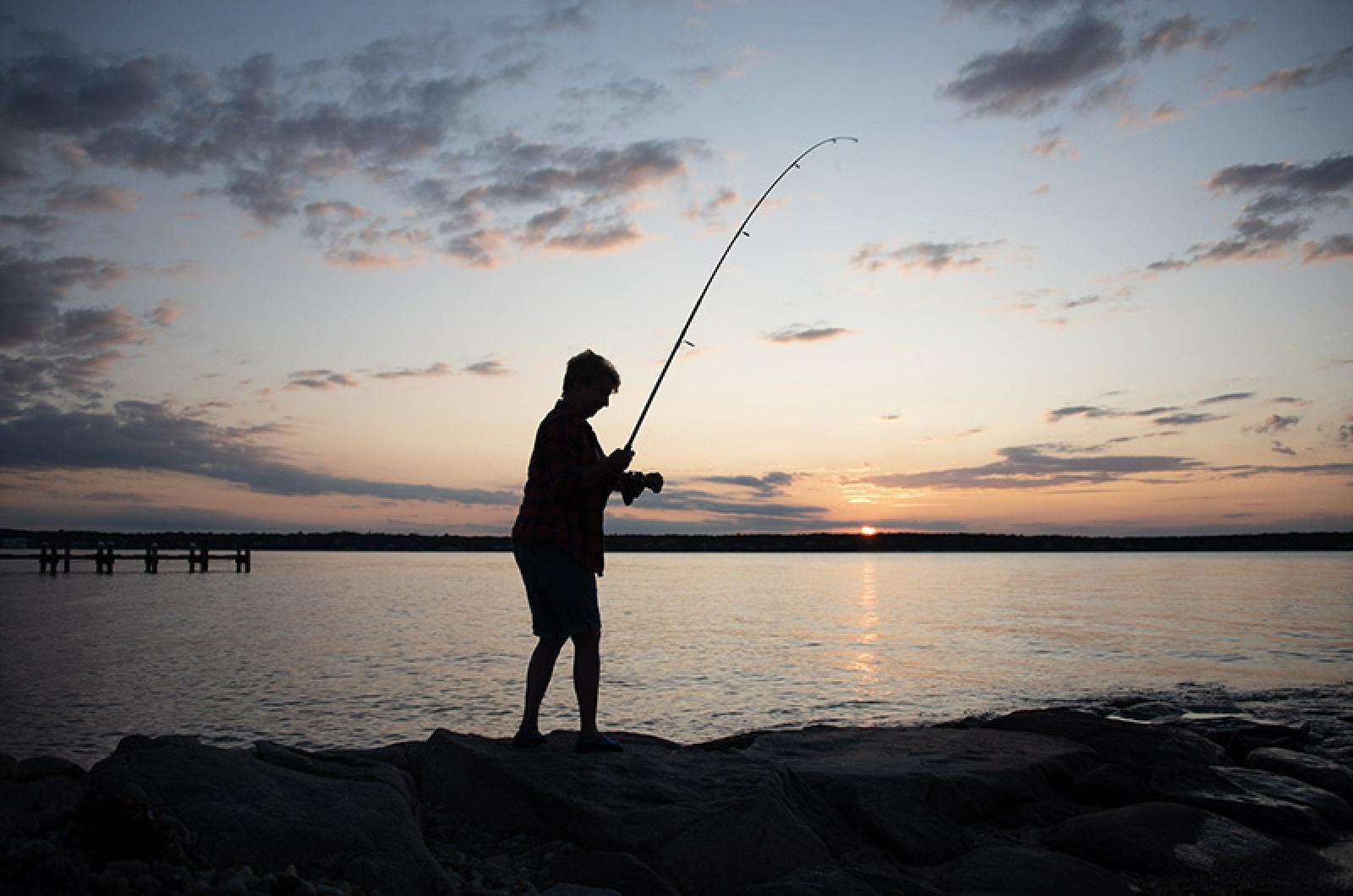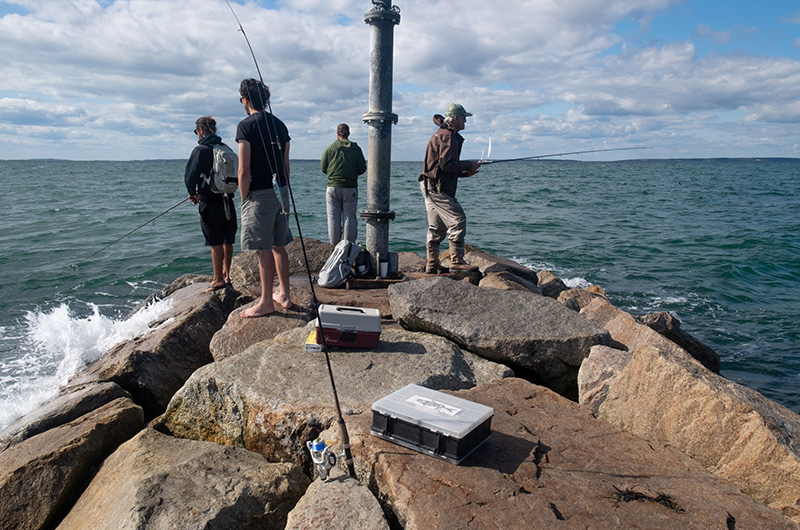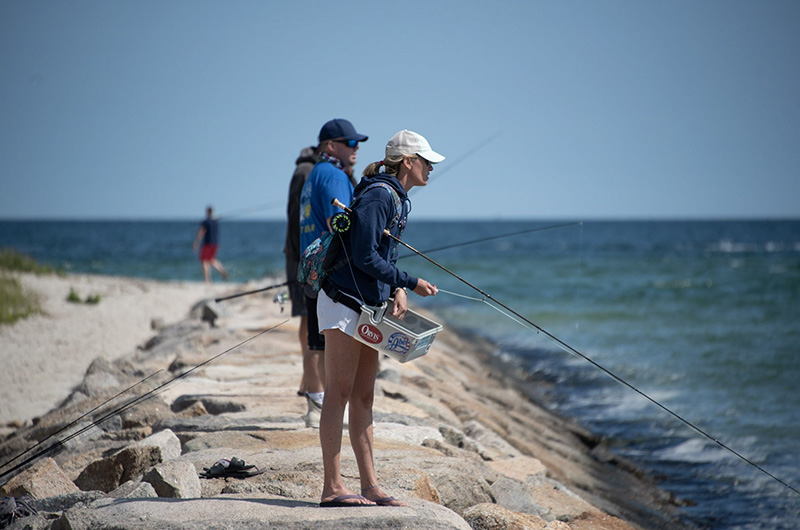Cooper Gilkes stands in his Edgartown tackle shop holding court as he often does in the days leading up to the derby. On his arm is a black wristband with white letters spelling “Edward J. Jerome.”
Derby hall of famer, longstanding president of the derby committee and former principal of the Edgartown School, Ed Jerome died last fall during the heat of the tournament. There are many photos of Mr. Jerome wearing a tie at the morning weigh station as he traded in his waders for a collared shirt before the morning school bell rang.
“I’m going to be fishing with Ed this year,” Mr. Gilkes says.
And so will many others when the curtain rises at 12:01 a.m. Sunday, Sept. 15 for the 74th annual Martha’s Vineyard Striped Bass and Bluefish Derby. The first weigh-in begins at 8 a.m. on Sunday at derby headquarters at the foot of Main street on the Edgartown harbor.
This year, Mr. Gilkes said the derby committee is taking measures to increase awareness of practicing proper catch and release techniques. This includes educating anglers on the importance of using circle hooks and raising the minimum length for weighing in a striped bass from 32 to 34 inches.
Circle hooks help reduce the risk of hooking a fish in the gut or the gills, increasing the likelihood that the fish will survive if it is released. The practice of using circle hooks will become mandatory coastwide in 2020. To get ahead of the effort, the derby is providing two Gamakatsu circle-hooks to the first 3,000 anglers to register for the Derby, along with educational material on how to properly set the hook.
The committee has also decided to change the Germani Catch and Release Award from luck of the draw to competitive. The award, an engraved plaque, will be based on the honor system and is aimed at promoting more catch and release fishing.
The most notable change is that the derby committee will be raising the minimum length of striped bass from 32 to 34 inches to be weighed in. A 32-inch fish is unlikely to win the derby and would be better off in the water than the weigh station, the committee decided.
Per tradition, hundreds of prizes will go to the daily and weekly winners who land the biggest striped bass, bluefish, false albacore and bonito by weight. Each of the anglers who catch the biggest fish by weight by the end of the derby on Oct. 19 will have a chance to win a 19-foot Cape Codder fishing boat, if the fish is landed from shore, or a 2019 Subaru Impreza, if the fish is landed from a boat.
But the most sought-after prize by fishermen is having their names tacked onto the long history of derby grand leaders, immortalized each year in the souvenir booklet.
As opening day approaches there is a certain stillness around the Island as anglers tuck away in preparation for the action to come — spooling their lines, tying teasers to their flies and not wanting to risk their luck by catching the big one too early.
There are also boats to get ready. Behind Mr. Gilke’s tackle shop is a 17-foot Boston Whaler, ravaged by time. The logo on the boat is peeling from the hull and the cap of the 90-horsepower engine lies in a field of ankle-high grass. Vines that had climbed up the trailer frame and latched onto the guard rails, locking the boat in place for the last five years, now hang limp from the gunwale.
Mr. Gilkes won the boat during the 1987 Striped Bass and Bluefish Derby, one of the years in which the tournament eliminated striped bass from the leaderboards to preserve the stocks which were then dwindling to the point of being endangered. He won the grand prize for his 10.19 pound bonito landed off Memorial Wharf in Edgartown. That was also the year the derby came into its own as a nonprofit organization, stepping out from under the umbrella of the Chamber of Commerce after it was purchased for $1 by a group of local fishermen, including Mr. Gilkes and Mr. Jerome, now known as the original members of the derby committee.
“Back in those years we all did anything we could to get the derby off the ground,” Mr. Gilkes says. “But Ed, he was the kingpin.”
He glances back at the boat. “It’s been overgrown with those weeds for five years. This year seems like the year to resurrect it.”
Other veterans of the derby agree that the tournament will be fished in remembrance of Mr. Jerome.
“Ed was an educator, that was his calling,” says John Custer, principal of the Tisbury School, who will be stepping in as president of the derby committee. “He was a leader and he was an educator. He would often say that one of the main purposes of the derby would be to educate people, whether it be about fishing or conservation. He loved to do it.”
Another Coop emerges from somewhere in the back of the tackle shop and places a rag down on the counter. Jackson Coop Fersen is not related to Mr. Gilkes but was named after him and now works at the tackle shop that bears his mentor’s name.
Mr. Gilkes asks him about the boat.
“It’s getting there,” he says.
In the meantime, in tackle shops all across the Island, speculation is beginning to boil as to what this derby might hold, where the fish might be, what they might be eating and which tides might lure them in.
Of course, everything is still a mystery at this point. The stories that will unfold over the next five weeks, whatever they might be, will be told when the final lines have been reeled in and fishermen gather for the awards ceremony on October 20.
“I think it’s going to be a really good year,” Mr. Gilkes says. “I don’t know why, I just feel it.”











Comments (2)
Comments
Comment policy »